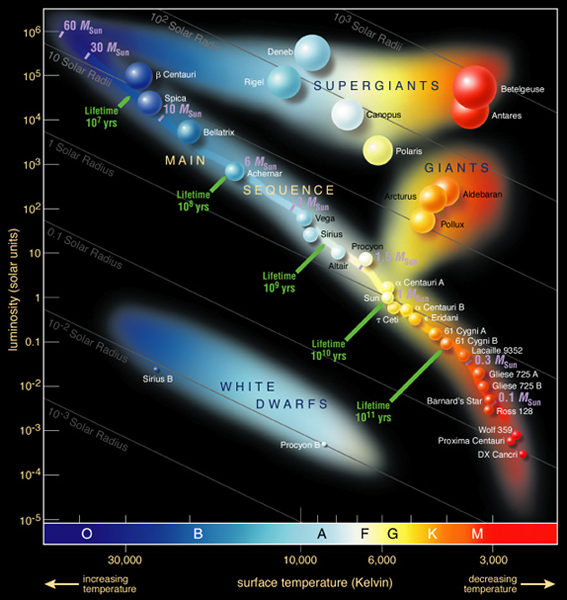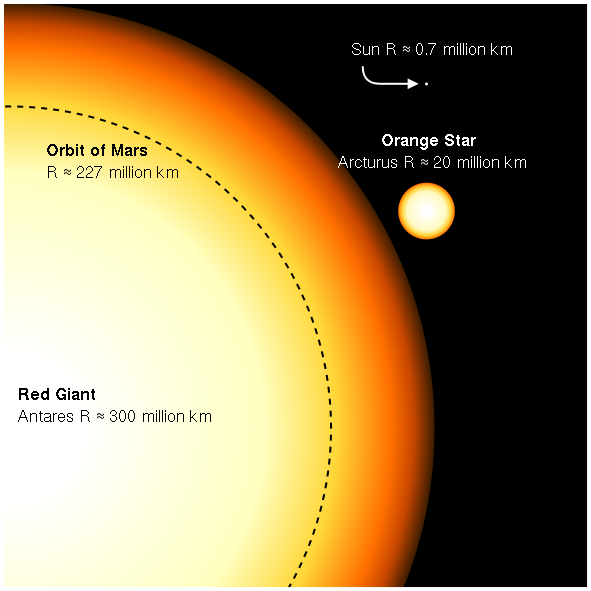
On the mornings of April 1 and 2, 2021, watch for the waning gibbous moon to be in the vicinity of Antares, the brightest star in the constellation Scorpius the Scorpion. You’ll be looking southward from Earth’s Northern Hemisphere, and high overhead or high in the northern sky from Earth’s Southern Hemisphere.
Antares is a huge red supergiant star, with 15 to 18 times the mass of our sun. It’s a truly enormous star, with a radius in excess of three astronomical units (AU; one AU is Earth’s average distance from the sun). If, by some bit of magic, Antares were suddenly substituted for our sun, its surface would extend well past the orbit of Mars! Unlike red dwarf stars (discussed below), the lifespan of supergiant stars is short (by stellar standards). Antares is only about 12 million years old, yet well into the autumn of its years. That’s in contrast to our sun, which is 4 1/2 billion years old, and middle-aged.
Notice the ruddy color of Antares. It indicates a low surface temperature of about 3,500 kelvins (5,800 degrees F or 3,200 C). That’s in contrast to a surface temperature of about 6,000 kelvins (10,000 F or 5,700 C) for our yellow-colored sun. Or contrast Antares to a very hot star, like blue-white Spica in the constellation Virgo the Maiden. Spica boasts a surface temperature of around 22,400 kelvins (39,900 F or 22,100 C).

A star that is blue or blue-white color, such as Spica at the upper left, has a high surface temperature. In contrast, a red-colored star (such as Antares and Betelgeuse at the upper right), has a lower surface temperature. Image of Hertzsprung-Russell diagram via Chandra/ NASA.
Most red-colored stars are invisible to the unaided eye because they’re small and faint red dwarf stars. Cool red dwarf stars are only a fraction the size and luminosity of our sun, but are thought to make up about 70% of the stars in our Milky Way galaxy. These red dwarfs are extremely long-living stars with an expected life span of about a trillion years (1,000,000 million years).
Red-colored stars that are visible to the unaided eye are fairly rare. In fact, all the bright red stars that we see in the night sky with the unaided eye are either red giants (such as the star Aldebaran) or red supergiants (such as the stars Antares and Betelgeuse).
Red supergiant stars are remarkably rare, accounting for one of every million or so stars in our Milky Way galaxy. Approximately 10 red supergiant stars are visible to the unaided eye in a dark sky. The great size of these red supergiants makes these stars quite luminous, despite being rather distant. For example, Antares is thought to reside some 600 light-years away, but this star shines at 1st-magnitude brightness all the same.

If Antares replaced the sun in our solar system, its circumference would extend beyond the orbit of the fourth planet, Mars. Here, Antares is shown in contrast to another star, Arcturus, and our sun. Image via Wikimedia Commons.
Bottom line: Let the moon show you Antares, the red supergiant star, on April 1 and 2, 2021. If your sky is fairly dark, you may or may not notice the graceful shape of Antares’ constellation – Scorpius the Scorpion – in the lunar glare.
from EarthSky https://ift.tt/3fvnNXc

On the mornings of April 1 and 2, 2021, watch for the waning gibbous moon to be in the vicinity of Antares, the brightest star in the constellation Scorpius the Scorpion. You’ll be looking southward from Earth’s Northern Hemisphere, and high overhead or high in the northern sky from Earth’s Southern Hemisphere.
Antares is a huge red supergiant star, with 15 to 18 times the mass of our sun. It’s a truly enormous star, with a radius in excess of three astronomical units (AU; one AU is Earth’s average distance from the sun). If, by some bit of magic, Antares were suddenly substituted for our sun, its surface would extend well past the orbit of Mars! Unlike red dwarf stars (discussed below), the lifespan of supergiant stars is short (by stellar standards). Antares is only about 12 million years old, yet well into the autumn of its years. That’s in contrast to our sun, which is 4 1/2 billion years old, and middle-aged.
Notice the ruddy color of Antares. It indicates a low surface temperature of about 3,500 kelvins (5,800 degrees F or 3,200 C). That’s in contrast to a surface temperature of about 6,000 kelvins (10,000 F or 5,700 C) for our yellow-colored sun. Or contrast Antares to a very hot star, like blue-white Spica in the constellation Virgo the Maiden. Spica boasts a surface temperature of around 22,400 kelvins (39,900 F or 22,100 C).

A star that is blue or blue-white color, such as Spica at the upper left, has a high surface temperature. In contrast, a red-colored star (such as Antares and Betelgeuse at the upper right), has a lower surface temperature. Image of Hertzsprung-Russell diagram via Chandra/ NASA.
Most red-colored stars are invisible to the unaided eye because they’re small and faint red dwarf stars. Cool red dwarf stars are only a fraction the size and luminosity of our sun, but are thought to make up about 70% of the stars in our Milky Way galaxy. These red dwarfs are extremely long-living stars with an expected life span of about a trillion years (1,000,000 million years).
Red-colored stars that are visible to the unaided eye are fairly rare. In fact, all the bright red stars that we see in the night sky with the unaided eye are either red giants (such as the star Aldebaran) or red supergiants (such as the stars Antares and Betelgeuse).
Red supergiant stars are remarkably rare, accounting for one of every million or so stars in our Milky Way galaxy. Approximately 10 red supergiant stars are visible to the unaided eye in a dark sky. The great size of these red supergiants makes these stars quite luminous, despite being rather distant. For example, Antares is thought to reside some 600 light-years away, but this star shines at 1st-magnitude brightness all the same.

If Antares replaced the sun in our solar system, its circumference would extend beyond the orbit of the fourth planet, Mars. Here, Antares is shown in contrast to another star, Arcturus, and our sun. Image via Wikimedia Commons.
Bottom line: Let the moon show you Antares, the red supergiant star, on April 1 and 2, 2021. If your sky is fairly dark, you may or may not notice the graceful shape of Antares’ constellation – Scorpius the Scorpion – in the lunar glare.
from EarthSky https://ift.tt/3fvnNXc

Aucun commentaire:
Enregistrer un commentaire